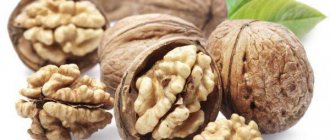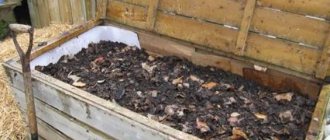general characteristics
Walnut is a deciduous tree with a huge life expectancy (several hundred years). Its height is 25–35 m. The large, wide crown is covered with complex leaves. The trunk is thick, with gray bark covered with cracks. The plant is monoecious, dioecious, bearing male and female flowers. Wind-pollinated. A fruit covered with a thick, fleshy skin, a false drupe. Underneath it is a useful kernel (80% of the weight of the nut), which is used for food.
This is interesting ! As a rule, there is little vegetation near the tree. This is due to the fact that the roots secrete a special substance, due to which the growth of other plants is inhibited.
Plant characteristics
Wikipedia indicates that walnut is a genus of tree from the Walnut family. Refers to long-term: in
Walnuts on the tree
In European forests, the plant is second only to oak. It is not uncommon to find specimens that are 300–400 years old.
Where does the walnut grow? The plant grows freely in northern India, Tien Shan, Transcaucasia, Ukraine and Greece. The largest forest areas remain in Kyrgyzstan - relict walnut forests, they can be seen in the pictures. For all its advantages, the tree is still heat-loving. Already at -25 - -28 C the plant freezes, so it makes sense to grow such a crop only in the southern regions of Russia.
Tree nut
The plant reaches a height of up to 25 m, has a powerful trunk up to 3–7 m in diameter, and dense smooth bark. The branches form a crown measuring more than 20 m. The leaves are complex in shape, the flowers are small and unattractive in appearance. The plant blooms in May, less often in June, the nuts ripen in October-November. Wind pollination.
The greatest interest is, of course, the fruits. This is a large drupe-like fruit, covered with a leathery green skin; inside there is a large spherical stone with 5 partitions. When ripe, the peel dries out and falls off on its own, leaving the seed intact. The edible part of the nut is in the pit.
The plant reproduces by both seed and vegetative means. Seedlings quickly take root, in the first
Sprouted nut
per year, the root length reaches 1.5 m, they begin to bear fruit at the age of 7–8 years, but the real harvest is produced only at 30–40 years. Copper plants - stump shoots - develop faster: fruits appear on them already in the 2nd year of life, and the tree produces a large harvest from 10 years.
Popular frost-resistant varieties
There are 4 forms of walnut: English or Persian , White , Black , Japanese . All of them are representatives of this family. Nut.
As for varieties, the walnut crop is southern, brought from Central Asia. And for a long time it was believed that its habitat was the warm regions of our country. Today on the market there are already winter-hardy, productive varieties that are practically not affected by pests and diseases, which can be grown in central Russia and the Moscow region.
- Dessert . It is distinguished by early ripening and nuts with a sweetish taste. Tree height is average. The crown is wide. The culture is drought-resistant. Winter hardiness is average: in cold weather the buds may freeze. Fruiting begins in the 4th season.
- Graceful . A low-growing tree (4–5 m) with an oval crown. Characterized by average resistance to frost. Nuts ripen in the 5th year. They are collected in early autumn.
- Aurora . Early, tall walnut. The fruits appear in the 4th year, and with the new season the yield increases. Resistant to frost, not susceptible to disease.
- Ideal . Early fruiting variety. Well known to Russian gardeners. It is loved for its high yield and winter hardiness (can withstand temperatures down to -35⁰C). The flowers form inflorescences and real grape clusters of nuts grow (up to 15 pieces).
It is important that the walnut has stepped beyond its habitat. Low growth, good yield, and resistance to frost make the crop accessible to central Russia.
general information
More than a thousand years ago, this tree arrived in Europe from Central Asia. It was brought to Russia by Greek merchants, which was the reason why the plant received such a name. Now it is being bred not only in hot countries of the world, but also in Russia, Moldova, Belarus, as well as in Ukraine and the Caucasus.
In ancient times, walnuts had several other names : “food of heroes”, “acorn of the gods”, “tree of life”. From time immemorial, people have respected and loved this powerful plant, because it gave them tasty and very healthy fruits. Other parts of the tree were also actively used, for example, the foliage was used for medicinal purposes.
The walnut is not only one of the largest, but also one of the longest-living species among all trees in the Middle Zone. Based on statistical data, we can say with confidence that some specimens lived up to 400–600 years. However, today the likelihood of meeting such a long-liver is extremely low, because walnut wood is highly valued and is actively used for the production of expensive luxury furniture and decorative elements.
According to experienced gardeners, the number of fruits that can be obtained from one tree primarily depends on the age of the plant. Thus, the yield of a young (up to 50 years old) walnut is not comparable to that which has managed to cross the hundred-year mark.
Description and characteristics
This walnut tree is considered tall. If the plant likes the place that is allocated to it on the site, and the gardener follows all the prescribed rules for caring for it, then the walnut can grow up to 18-23 meters in height.
The spreading crown of the tree can reach 15 meters in diameter, and the branches diverge at right angles. It should be concluded: before planting such a plant in your garden, you should take a responsible approach to choosing a location so that the grown tree does not spoil the appearance of the site, does not touch the buildings with branches and does not block sunlight from other plantings.
The walnut tree has a very powerful and branched root system . During the first three years, the main tap root develops; as it grows, it tends to penetrate into the very depths of the soil and gain a foothold in it. At 4-6 years of life of the tree, lateral roots are formed, they diverge 5-6 meters in different directions from the main one.
Such roots are located close to the soil surface, but only 30-50 centimeters deep. This perfect root system helps the adult plant not to suffer from low rainfall and insufficient watering, since the large capture area allows it to independently find water.
If you cut down an adult walnut tree, but do not touch the stump that remains from it, then after a while young shoots will begin to grow from the stump, from which in 1-2 years it will be possible to harvest the first harvest. Take this feature into account if you want to get rid of the tree forever, because in this case it is not enough to simply cut it down, you will have to uproot the stump. There is no need to worry about the roots remaining in the ground - they are not capable of producing new shoots.
This nut blooms in spring (April-May) and lasts about 2-3 weeks. Flowers bloom at the very beginning of the growing season, without waiting for all the leaves to form. At the tips of annual shoots, female flowers are formed, on the remaining branches - male flowers, which come together in 5-10 pieces and form earrings.
In the climatic conditions of the middle and southern zone, repeated flowering can be seen, usually in mid-June. The walnut tree is a self-pollinating plant; the fruits ripen in mid-autumn (September-October). It is worth noting that nuts from different trees often differ in size and taste.
Varieties for the middle zone
Today, Russian gardeners choose one of 20-25 hybrid varieties to grow walnut trees in the climatic conditions of the middle zone. These varieties were bred specifically for our regions; they are characterized by high yields and resistance to low temperatures.
The following varietal species are most suitable for Russian garden plots:
- “Harvest” - distinguished by a high oval-shaped crown and spreading branches. It is very frost-resistant, so it has been successfully grown in the middle zone for a long time. Another positive quality of the variety is considered to be an early harvest - it can be harvested already in early autumn, before the weather gets colder and the rains begin. Resistant to most insect pests and diseases that affect walnut bushes and trees.
- "Dessert". The variety is suitable for growing in hot regions, as it is resistant to drought, but does not tolerate cold weather (due to low temperatures, the buds and bark crack). It is quite miniature (up to 3 meters in height), but has a dense crown, suitable for small summer cottages. From a tree of this variety you can get a good harvest - 20-27 kilograms of nuts per season.
- "Abundant." It grows up to 5 meters, produces the first harvest 4-5 years after planting. From one tree you can get up to 30 kilograms of nuts per year. They grow in clusters of 8-10 fruits. It is recommended to avoid this variety if you live in the northern regions, since “Izobilny” is not resistant to frost and cold winters. It has high immunity to diseases such as fusarium and brown spot. Gardeners note the excellent taste of the fruits of this variety.
- “In Memory of Minova” is the most popular variety in our country. It gained recognition among gardeners due to the early ripening of its fruits. The tree produces its first harvest 5-6 years after planting. The nuts are flattened, large, the shell is thin, and has a silvery tint.
- “Graceful” is a massive plant up to 5 meters high. It has a dense crown, resistance to diseases, frost, and insect pests. It bears fruit in mid-autumn; the first harvest can be expected in the fifth year after planting. The average yield is 20 kilograms of nuts per season.
- "Black Walnut" It got its name because of the large fruits in a hard and thick black peel. The tree grows very tall and produces its first harvest only in the 10th year of its life. Loves sunlight and moist soils. In winter, young plants need additional shelter; mature specimens tolerate low temperatures well.
- “Ideal” is a fast-growing variety that produces the first harvest 3-4 years after planting. When a tree reaches 12 years of age, its productivity increases to 120 kilograms of nuts per season. It is recommended to plant away from buildings, as it has a highly branched root system that develops a large area of land around it. This plant requires good lighting; it prefers loamy soils of medium humidity.
Landing
The best method of propagation is to obtain a crop from seeds. In this case, you can be sure what fruits you will get in the end. Select a tree and collect several fruits from it. The seedling grown from such fruits will be well acclimatized to local conditions.
Attention! To grow a crop, it is worth planting more than one tree. The distance between seedlings is 5 m. Keep in mind that over time the crown will grow. On slopes, denser planting is permissible - every 3.5 m.
Walnuts should be planted in sunny, illuminated places. In relation to soils, the plant is unpretentious. It is “satisfied” with different types of soil and varied terrain. But it should not be planted in wet, sandy or poorly aerated areas. Close proximity to groundwater is undesirable.
The landing technology is as follows:
- We plant in the spring, because autumn planting can lead to the death of poorly strengthened seedlings from frost.
- Planting time is April (more specifically, the time is determined based on the region).
- The planting hole (50x50 cm) is prepared in advance; a rich earthen mixture is poured into it. Mixture composition: compost + ash + superphosphate. You can add humus.
- We straighten the roots, gradually sprinkling them with earthen mixture. We water it. We compact the soil around the seedling.
- The root collar is covered with soil by 5 cm.
The first fruits should appear in 4 years.
Planting in the garden
When planning to create a walnut orchard on your site, you must adhere to the following rules:
- If you want to plant several trees in one area, keep in mind that they have a spreading crown and a very branched root system. Therefore, the distance between planting pits for seedlings should be at least 5-6 meters.
- An adult nut has a thick and lush crown, which can shield other plantings from the sun. Also, such a large tree needs a lot of moisture and nutrients for healthy growth and development; the plant pulls all these elements from the soil around it. Therefore, when choosing a place for a seedling, remember that within a radius of 10 meters from the tree, other crops will not be able to grow, much less bear fruit.
- Do not plant walnut trees near buildings. Its roots can cause the destruction of the foundation.
- The tree loves sunlight, in a dark place it will lag behind in development and then die.
- This plant will do well in loose, well-drained soil. Do not place it in areas with high groundwater levels or areas prone to flooding during rains and floods.
- Do not plant other fruit trees next to the nut, as during photosynthesis it will release substances that have a detrimental effect on such plants.
Climate requirements
This heat-loving plant is best grown in the southern regions. In the central part of Russia, it is also able to take root and then bear fruit regularly, but only if the air temperature in winter does not drop below 25 degrees. Severe frosts in most cases lead to the death of the tree.
Today you can purchase seedlings of hybrid forms of walnut. Some of them are able to withstand temperatures up to 30 degrees below zero, but they cannot boast of a bountiful harvest, and they do not bear fruit every year.
If the winter cold leads to freezing of branches and shoots, then you can’t expect nuts this season. Mature trees tolerate drought and heat calmly, but young plants (up to five years old) need to be watered 2-3 times a month. In particularly dry times, the amount of watering should be increased.
Planting trees in the ground
The time for planting seedlings depends on the region:
- Southern strip - autumn. Then the tree will have time to take root before winter and will not waste energy on growing the crown. He will not require additional care at this time of year. If you decide to plant a seedling in the spring, it will not have time to get used to the new place and will die from the heat when summer comes.
- Middle zone - mid-spring. In such regions, the heat comes late, so the tree has time to get stronger and take root.
When a suitable location has been selected and the time for planting has arrived, you can begin the process itself:
- Dig a planting hole measuring 50x50 cm and 45-55 centimeters deep.
- Fill the bottom with drainage material; it should fill 50% of the hole. Crushed stone, clay shards, expanded clay, and broken brick are perfect for this purpose. This technique will help to slightly shift the beginning of the growing season. The stones will warm up later than the ground and the tree will begin to bloom, missing the last frost.
- Fill the remaining space with fertile soil mixed with wood ash and humus (can be replaced with compost).
- Drive a peg into the center of the planting hole. It will serve as a support for the tree until the lateral roots begin to develop.
- Place the seedling in the hole up to the root collar. It should be level with the soil.
You can also try to grow a new tree from a walnut. It is believed that a plant obtained in this way will develop more successfully, since it will have time to adapt to new conditions even at the seed stage. For this:
- Dig a hole 7-10 centimeters deep.
- Place the nut in it, seam side down.
- Cover with fertile soil and water.
- Apart from watering, the seedlings will not need anything else. In the middle zone there are no pests that could covet such a plant.
It is worth noting that if you want to plant a seed in the spring, then place it in wet sand 2-3 months before. This will help the nut prepare for planting in the ground and increase the chances of germination.
Care
Walnut - planting and care
The plant does not require care. While it is small, you can grow vegetables between the trees.
| Care | Conditions for culture |
| Watering | It is necessary to water twice a month as soon as the plant begins to grow. During periods of drought, when the soil dries out, watering is also important. For wood – 30 l. water per m². |
| Feeding | We fertilize the crop 2 times a year: nitrogen - in the spring, potassium and phosphorus - in the autumn. |
| Temperature | Walnut loves warm climates with a gradual transition to winter dormancy. Modern varieties can withstand more continental climates and lower temperatures. But spring frosts can damage young shoots and fruit buds. |
| Relief | It is better to plant walnuts on a flat surface. Slopes are suitable, but the slope is no more than 10⁰. Prefers southern and southwestern slopes. |
| Wind | Wind is necessary for pollination, but plantings must be protected from strong winds. |
| Pruning and crown formation | It is important to lay the first branches of the skeletal layer. When pruning, leave 4 branches in different directions at an angle of 45⁰. Young, standard shoots are removed. Subsequently, the tree forms independently. Only sanitary pruning will be necessary. |
Attention! Nitrogen fertilizers must be applied with great care, as they can cause the development of bacterial diseases. At the beginning of seedling growth, you should not add them at all.
How to germinate a nut in a pot
When all the elements are prepared, they can be planted in open ground immediately or, if desired, first placed in pots to allow them to germinate. After the tree has gained strength and taken good roots, replanting it in open ground, you can expect that germination will be better and wintering more successful. If you are thinking about this option for germinating a tree, you need to know what containers and substrate to prepare.
soil mixture
It can be purchased in special stores or prepared with your own hands. For this you will need turf soil, peat and humus. All in one piece.
Capacity
You need to prepare two containers. The optimal size of the first container is approximately 30*30 centimeters. Its dimensions should be sufficient for the development of roots.
Seedling
The second one needs to be taken twice as much for small sprouts.
Landing
The fruits are introduced into the ground in the second week of April or already at the end. 1/3 of the pot is filled with drainage. A mixture of soil is poured onto it. Then a hole is made and the fruit is placed there to a depth of 7-8 centimeters. The end should look down. The substrate is poured on top. Then the resulting product is watered and placed at a temperature of 25-28 degrees above zero. In this case, the pot should receive a lot of light for 5-10 days.
Some gardeners place glass on top of the pot. This creates a small greenhouse. But then you will need to periodically ventilate the container. In about 1-2 weeks you will be able to observe the first sprouts.
Walnut in permanent place
Walnut seedlings can be planted in the fall. In this situation, the container is moved to a cool place before February. This could be a balcony or a cellar. Then return to a warm place and systematically moisturize. After 10 days, sprouts may appear. They are transplanted into a larger pot, placed on the windowsill and also watered regularly.
Seedling care
Caring for walnuts in the middle zone includes the following points:
- Give enough light to the seedling. Otherwise, the plant will die, despite the fact that it may have grown well at first.
- Water thoroughly. It is important to ensure that the soil does not dry out. A walnut tree is more difficult to tolerate a complete lack of water than too much water. But you also cannot overdo it with overwatering, as this threatens the seedlings with rotting.
- When warm weather sets in, the container with seeds should be moved to the open air to ventilate. But this must be done without drafts. When it’s hot outside, the nut is wrapped in a cloth soaked in water. This helps avoid overheating the roots. In case of very high temperatures, the container can even be placed in cold water.
Walnut blossom - If necessary, the mulch needs to be updated. It may include moss, rotted organic matter or peat.
- When the nut is growing, then every 14 days, it is necessary to fertilize the soil with a composition that contains potassium with an increased index.
Why doesn't the tree bear fruit?
There are times when a walnut does not bear fruit, and there are reasons :
- It is typical for young trees in case of strong thickening of branches. It is necessary to remove excess branches and thin out the crown.
- Good growth, but no flowering. In this case, they say that “the tree has become fat.” It is necessary to stop watering and fertilizing. If this does not help, then you need to trim the roots.
- The walnut blooms, but does not form ovaries. Take a branch with ripe pollen and shake it over a tree where the ovary is not forming. That is, pollinate the nut artificially.
Varieties
The future size of the tree, yield, taste of the kernels, thickness of the shell, shape and shade of foliage depend on which variety the seedling belongs to.
Walnut Chandler
The Pancake week variety of walnut comes from California, where it was obtained in 1979 and named after the famous American botanist William Chandler. In the USA it is the most common. Seedlings bear fruit 3-4 years after planting. Flowering is later, which serves as protection against late return frosts. 1 hectare of plantings yields a harvest of up to 4-5 tons. Oval smooth fruits are up to 4 cm in diameter, in the shell they weigh up to 16 g (the almost white kernel weighs up to 6.5 g). The variety has very high drought resistance. For cross-pollination, varieties Franguette and Fernette are recommended.
Walnut Robert Livermore
This variety is one of those that bear fruit already 3-4 years after planting. The red walnut was introduced in the USA in 1999 and became the basis for other red-fruited varieties. The unusual shade of the skin of the kernels does not radically affect the taste, but it looks advantageous in desserts, for which it has gained high popularity in cooking. A tree up to 6 m high usually blooms in May, and the fruits ripen in August-September. Frost resistance – down to -37°C. The variety is characterized by consistently high yield (up to 60-90 kg per tree) and resistance to diseases. The weight of a large fruit is up to 30 g, the taste is pleasant and oily.
Canadian Chandler
A low-growing variety of almost dwarf walnut (on average 3-5 m tall), bearing fruit even in the climatic conditions of the Moscow region. Seedlings after planting give the first harvest in the 3rd year. Flowering occurs in May, and the nuts ripen in September. On average, the weight of the fruit is up to 30 g, the taste is sweetish and oily. The shell is easy to clean. The highlight of the variety is the beautiful bright yellow color of the foliage in autumn.
Reproduction
Ripening of walnut fruits
You can get a new plant by seeds, vegetatively, or by grafting .
Propagation by seeds
Before planting, the seeds are soaked in water and then in the growth preparation “Zircon” for 3 days. Planted in April, when the soil warms up to 10⁰C in previously prepared fertile soil. Planting depth – 10 cm.
When planting, we do not throw the nut, but place it sideways on the edge. Under the “open sky” growth is slow; seedlings grow much faster in film greenhouses. The interesting thing is that in terms of their qualities they can surpass the mother plant.
Vegetative propagation
Walnuts can be propagated by ground shoots that grow in the root collar area. Development is much faster than that of seedlings. Fruiting occurs already in 3–4 years. If propagated by cuttings, then shoots of the current year are used. Planting: end of April or November.
Reproduction by grafting
2-year-old seedlings are used as a rootstock. Vaccination is carried out in March. In the northern regions, seedlings are grown in containers and left in a warm room in December. And they vaccinate in February. Planting in open ground occurs in May. With this method of propagation, the qualities of the “mother” plant are completely preserved.
It is important !
Seeds must go through a period of stratification (preparation for sowing). This will take from 2 to 3 months (depending on the thickness of the shell), all this time the nuts will spend in damp sand in a cool place. A month before planting, the nuts are transferred to a warm place, where they are kept in water and growth stimulants.
How to choose a nut for planting
The success of growing the tree depends on what fruit is planted. The nut should not be dried or heat treated before planting. Most often, dried fruits are sold in stores. But after the harvest in September and early October, you can still find fresh nuts from the new crop that can germinate. It's better to assemble them yourself. They must be ripe and not damaged.
If the tree is grown on a windowsill as an ornamental crop, you can take any kind of nuts for planting. But if it will grow in the garden and bear fruit, then it is better to choose a variety suitable for certain climatic conditions. Varieties intended for warm climates will not take root in northern latitudes. Just like cold-resistant nuts may not withstand hot and dry air.
Pests and diseases: control measures
Compared to other trees, walnut is less often affected by pests and diseases. But nevertheless, some “friends of the garden” visit it:
- American white butterfly . It produces three generations over the summer, and the third is the most harmful. The butterfly caterpillars, having settled on the leaves, gradually move throughout the tree. To combat them, microbiological preparations or insecticides can be used.
- The walnut or apple moth brings 2 generations. The caterpillars crawl inside the nut, eating away its contents. Infected nuts fall off. The method of control is pheromone traps that attract males. Reproduction is reduced, and there are fewer caterpillars. They are treated with viral drugs that cause caterpillar disease and death. A mechanical method is also used: collecting caterpillars and affected fruits by hand.
- Aphids settle on young shoots and buds, forming colonies on the inner leaf surface. Chemicals are used for destruction.
- Sapwood is a beetle that lives under the bark, so it is difficult to detect. Gnawing out the bark of a tree, it leaves behind curved channels. Beetles settle on weak plants and cause abundant sap flow. Over the summer, 2 generations are formed. Control measures: spraying with insecticides. Prevention - sanitary cutting of damaged branches.
A tree can also get sick for physiological reasons: poor soil, lack of light, excess moisture, spring frosts, poor care.
Most often, walnuts are affected by brown leaf spot , fire blight , bacteriosis , and root canker .
Crown formation and pruning
The next important nuance is shaping and trimming. The tree grows quite successfully in Belarus, Ukraine and central Russia, provided that it has enough light. Compared to a wild one, a correctly formed tree, thanks to sufficient sunlight, develops much, simply and many times better, and subsequently bears fruit.
The methods for forming the crown may be different. A separate section on the All Agro website is dedicated to this.
An adult tree must be regularly thinned to an already formed crown, approximately once every 2-3 years, to ensure the most even access of all leaves to sunlight. In mid-latitudes, issues of heat and sun play a significant role , so this particular task should be approached with particular responsibility.
How to cover a walnut for the winter?
We have obtained winter-hardy varieties, but winters can be light and cold, and the tree needs shelter.
Even before frost, you need to wrap the root collar, trunk and skeletal branches with covering material. You can insulate with agrofibre, burlap, roofing felt, linoleum. The base can be covered with spruce branches and pine branches. This will protect the tree from severe frosts and winds. In spring the tree will be healthy and ready to bear fruit.
It is important ! When the snow falls, they need to throw the walnut up to the skeletal branches, covering the entire trunk. Throw spruce branches on top. This way the tree will survive the winter better. In addition, the root system will not be damaged.
When and how are walnuts collected?
Fruit ripening occurs unevenly. Therefore, harvesting is usually delayed for several weeks. Due to the fact that the tree is tall, it is almost impossible to carry out this procedure manually. Therefore, experienced gardeners use a special roll to collect walnuts, which greatly simplifies and speeds up the process. The tool helps to collect fallen fruits and does not require complicated actions.
How to tell if walnuts are ripe
When growing this crop, it is important to harvest the crop in a timely manner in order to protect it from pests and the negative effects of soil moisture. Walnuts should be collected as they fall to the ground, which is one of the signs of ripening.
Fruits should not lie on the ground for long
Also, the need to harvest is indicated by cracking of the upper peel of the fruit. Sometimes this happens right on the tree. In this case, you should knock down the walnuts with a long stick.
Important! Experienced gardeners recommend collecting fruits within 24 hours after falling to the ground to avoid mold and damage by rodents.
Rules for collecting walnuts
In order for the crop to be stored well later, you should follow some recommendations when harvesting.
Basic Rules:
- Walnuts with and without pericarp should be collected in separate containers. Keep fruits with a protective shell in a dark room until it bursts.
- Collection is carried out using long objects or a special tool.
- Harvest daily as the nuts fall off.
- Subsequently, the fruits should be thoroughly dried in the sun.
Beneficial features
Walnuts
The beneficial properties are obvious, since the fruit contains:
- Vitamin E “solves problems” of the cardiovascular system, lowers blood pressure;
- Antioxidants rejuvenate, reduce the risk of cancer;
- Potassium is important in metabolic processes;
- Fiber plays a role in intestinal motility, weight loss, and obesity prevention.
- Cobalt, iron, zinc increase hemoglobin levels, preventing anemia.
In addition, walnuts increase potency in men, have a general strengthening effect, and have a positive effect on brain function due to their high protein content. Calorie content of the fruit – 653 kcal/100 g.
Attention! The product is high in calories, consume it in moderation. To maintain health and well-being, it is enough to eat 7 nut kernels a day.
What grows under a walnut
When growing this tree in the country, the lack of space for planting other crops becomes noticeable. But, according to many gardeners, many plants can fully develop at the base of the walnut, despite its dense crown.
Under the young seedling you can plant fruit bushes, namely raspberries, gooseberries, and currants. The tree will protect them from gusts of wind, and fallen leaves will serve as additional food. In addition, walnuts release phytoncides that repel insect pests.
The soil at the base of the tree can also be used for growing spicy and medicinal herbs, since they are shade-tolerant.
The space under the walnut can also be used as a flower bed. It should be used to grow spring bulbs, which will have time to bloom before the tree leaves bloom. As well as shade-tolerant perennials, such as astilbe, hosta, loosestrife, lungwort, fern, and creeping ornamental foliage crops.
Important! In order for plants to better tolerate such a neighborhood, they should be placed at a distance of 0.5 m from the trunk on the south or east side.
Harvesting
Green (unripe) nuts have a soft kernel and skin. These fruits are collected in May. They are pierced with a needle and if juice flows out of the hole, collection can begin. The fact is that unripe fruits are very useful, they are rich in many substances and are widely used in folk medicine. In cooking, they are used to prepare compotes, marinades, and jams.
Video about planting walnuts and caring for them
Now, with the advent of frost-resistant varieties of walnuts, every gardener can grow this very healthy and tasty nut on their plot. Use the information from our article and everything will work out for you!
Spring planting technology
In May-June, before the onset of intense heat, the sprouts sprouted in the sand and grown over the winter are transplanted into the ground.
- Hardening off: Take the pots outside for a few hours every day, gradually increasing the time spent outside until you start leaving them in the garden all day long.
Take the seedlings outside in the sun so that they have time to adapt to the time of planting
- The landing site is warm, protected from the north and west by a wall, trees, and a fence.
- A planting hole is prepared: humus is placed at the bottom and covered with earth.
- The seedling's roots should not touch this nutrient layer. If the nut has not yet produced roots, then it is placed “on its edge” with its nose facing north. To do this, make a hole on a mound 5 cm high.
- The nuts are planted at a distance of 1-3 m from each other so that the bush can grow 2.5 m wide.
- All nuts are planted at a distance of 8-10 m from other fruit trees.
After planting, make sure that magpies and crows do not peck the sprouts. To do this, you can place a bucket without a bottom or a cut-off plastic bottle with the neck up on the seedling.
How to plant
For walnuts, it is advisable to select flat or elevated areas of soil with a neutral composition, and not shaded, but sunny places. When planting several specimens at the same time, it is necessary to maintain a distance between them, which should not be less than eight meters. Agronomists recommend planting nuts in the spring, but the planting process is divided into two parts - the autumn and spring stages.
Autumn work
The soil for planting seedlings requires preliminary preparation; it is prepared in the fall. Starts at the end of September:
- you need a hole of equal depth and width, about a meter;
- The top layer of excavated soil is mixed with an equal amount of peat and humus. Then two kilograms of superphosphate and wood ash, eight hundred grams of potassium-based fertilizer, five hundred grams of chalk or dolomite flour are added to the resulting soil mixture;
- The prepared pit is filled with the substance formed as a result of mixing. Then twenty liters of water are poured there and left for the winter. Further work is carried out in the spring.
Spring planting
With the arrival of spring, in April, they begin to plant walnut seedlings. The soil is removed from the hole prepared in September, and a stable, strong support is hammered into the bottom, the height of which should be about three meters. In addition, small stones are poured there, drainage is made from them with a layer thickness of 20 centimeters, and a substrate is sprinkled on top of it. Before placement in the soil, the roots of the crop are treated with a pre-prepared mixture consisting of three parts clay and one part rotted manure and water. The bush is placed so that the upper part of the stem is above the surface of the ground and protrudes about three centimeters. The roots around are sprinkled with earth.
After planting the bushes, they need to be thoroughly watered. Typically, trees are watered at the rate of 25 liters of water per seedling. The moisture is absorbed and the bush is tied to a support. Near the trunk you need to pour a two-centimeter layer of sawdust. After all these manipulations, the walnut will grow.
Varieties
There are several types of walnuts, they differ in terms of ripening, weight and number of fruits, resistance to diseases and pest infestation.
The most famous varieties:
- “Skinossky”: reaches a height of 12 meters, the crown is voluminous and dense, a frost-resistant tree. The weight of mature nuts is 15 grams, with large kernels. Can be eaten in the second half of the first autumn month;
- "Codren": grows in Moldova. The fruits are round in shape, weigh more than 10 grams, with a thin peel;
- "Santa Rosa Soft Shell": its homeland is California. It has a light shell and white kernels;
- “Dessert”: domestic variety. The nuts ripen early, the crop is drought-resistant and loves warmth. The peel is of medium thickness, the fruits are large, spherical in shape;
- "Giant": grows in temperate climates. The fruits are not too large, their weight is about 8 grams, but they are distinguished by their rich yield.
Be careful!
But, as they say, everything is good in moderation. Since walnuts are a very high-calorie product, its consumption should be limited to people who are prone to being overweight or obese. Increased blood clotting and intestinal disorders are also indications for limiting the consumption of this product.
Walnut is recognized by nutritionists as an allergen, excessive consumption of which causes a rash on the oral mucosa, diathesis, urticaria, inflammation of the tonsils, nasal congestion, and insomnia.
So, in our article we told you everything about the walnut tree. This plant is an angiosperm and belongs to the order Beech family Nutaceae. This is a powerful tree with a well-developed root system and spreading crown. It is heat-loving, so its distribution area is in the southern regions. However, breeders have developed a number of nut species that can withstand temperatures as low as -40 degrees. The nut blooms in late spring and bears fruit in the fall. They belong to the type of false drupe. Man uses walnut kernels, partitions, peel and wood in his economic activities.











